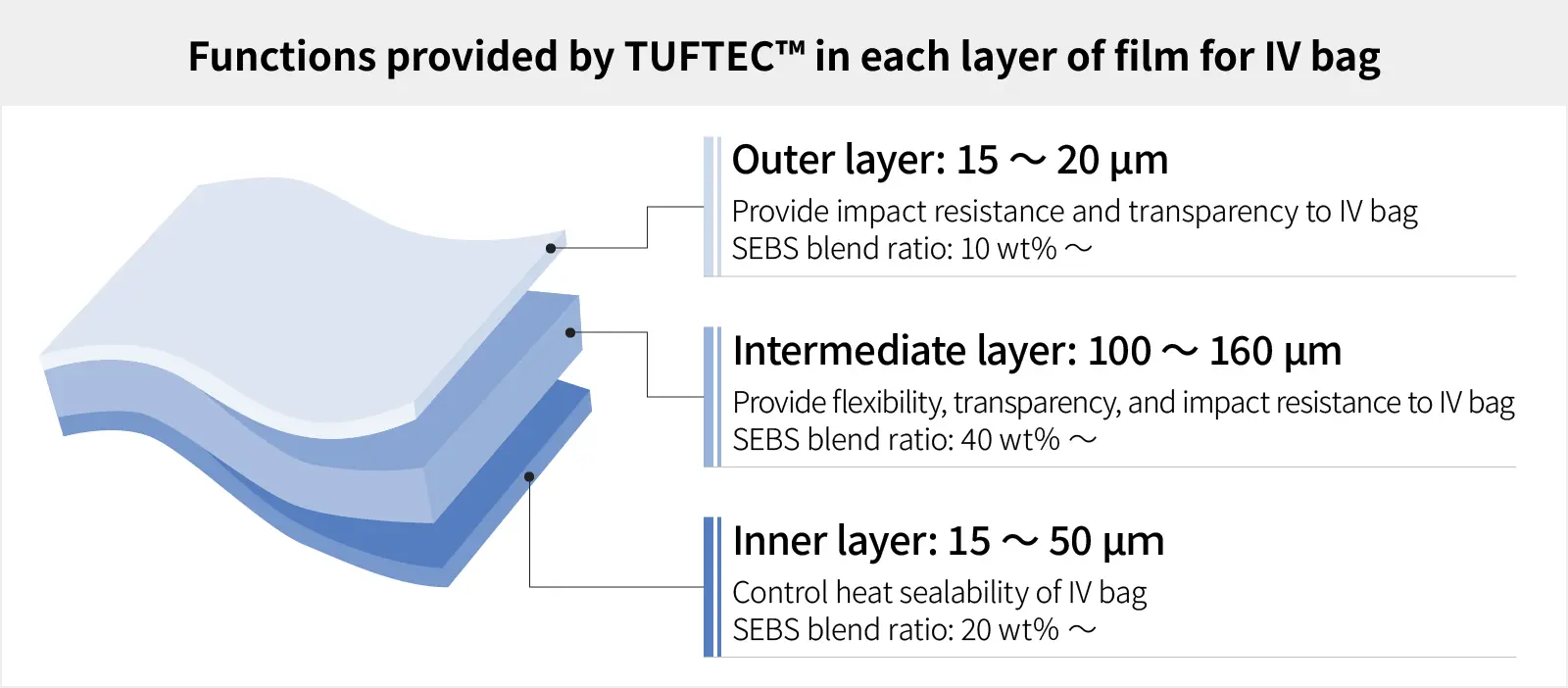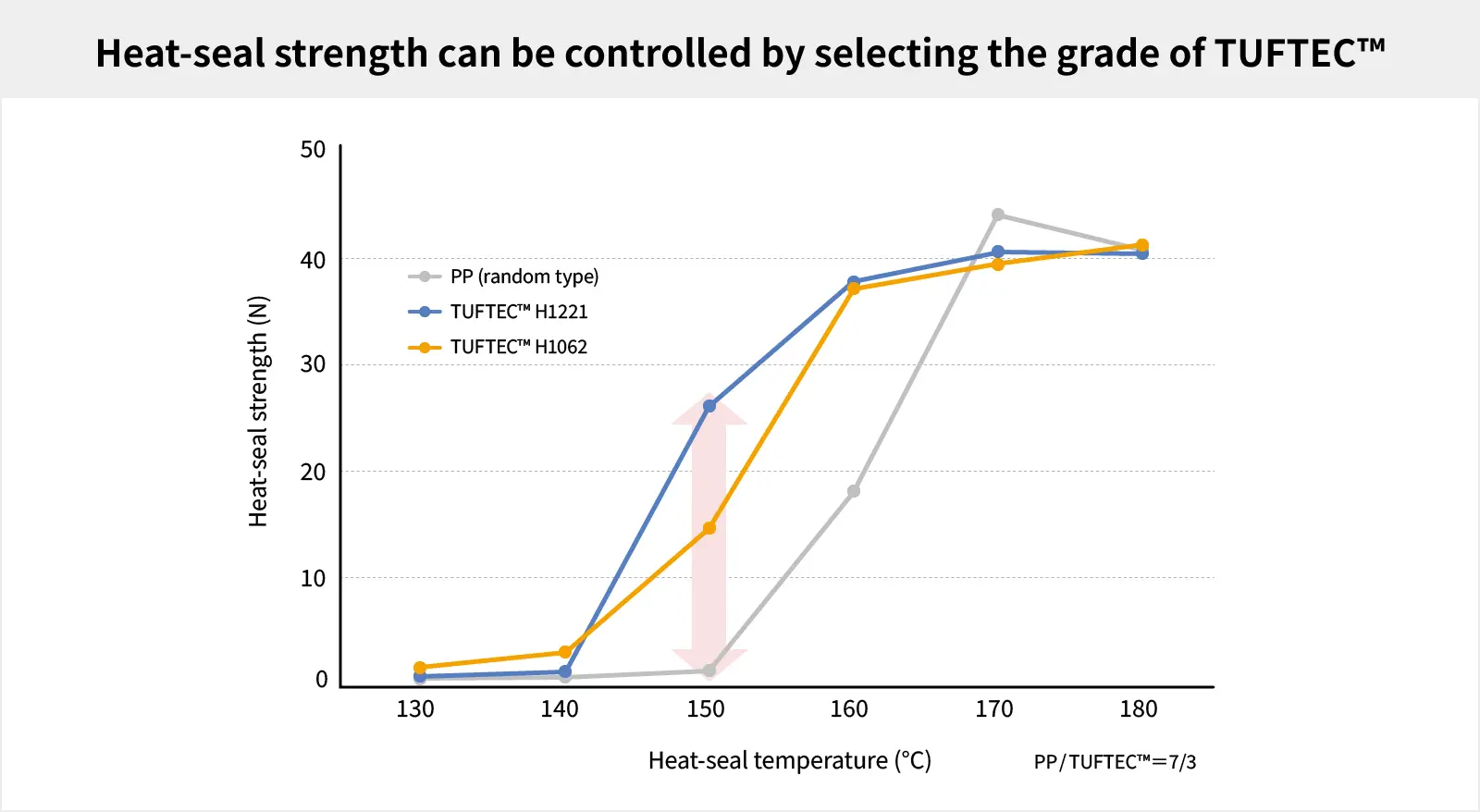TUFTEC™ for More Flexible Film Design in IV bags
By blending Asahi Kasei's TUFTEC™ into polypropylene (PP), you can give IV bag films a variety of functions (impact resistance, flexibility, heat sealability, transparency).
Furthermore, these functionalities can be freely adjusted by the blending ratio of PP and TUFTEC. It solves the trade-offs that you had to give up in the past.
TUFTEC™ balances functionality in each layer of the film
Polypropylene (PP) films for IV bags consist of three layers: the "outer layer," "middle layer," and "inner layer." Each layer needs to possess a balanced combination of various functions, such as impact resistance, flexibility, heat sealability, and transparency. However, there is typically a trade-off between these characteristics.
TUFTEC™ makes it possible to solve trade-offs and supports more flexible film design by adjusting the blending ratio with PP. The following provides a concrete explanation of the effects of TUFTEC™ in each layer.
Outer Layer: Achieving both impact resistance and high transparency to protect the bag from damage
The outer layer of an IV bag requires high heat resistance for processes such as steam sterilization and heat sealing, so homopolymer PP with a high melting point is used.
However, homopolymer PP has high crystallinity, making it susceptible to impact damage. Additionally, a high degree of crystallinity leads to low transparency.
TUFTEC™ is widely used to solve these problems in the outer layer. TUFTEC™ features excellent low-temperature properties, and blending it into PP in the appropriate ratio can improve the impact resistance of the outer layer film. Furthermore, the high compatibility of TUFTEC™ with PP can also improve the film's transparency.
Middle Layer: Achieving a balance of impact resistance, flexibility, and transparency
The middle layer of an IV bag's polypropylene (PP) film is a crucial layer that needs to exhibit a wide range of properties, including impact resistance, flexibility, and transparency. These functions can be achieved by adjusting the blending ratio of TUFTEC.
In particular, by using TUFTEC™ H1221 and H1062 together, you can achieve a balance of these functions. H1221 is highly compatible with PP and is blended in to enhance transparency and flexibility. Meanwhile, H1062 has a very low glass transition temperature, so blending it into PP improves impact resistance.
TUFTEC™ allows for the free adjustment of the functionality to be added by the blending ratio with PP and the combination of grades used.
Inner Layer: Flexible adjustment of heat seal strength and improved yield
The inner layer of an IV bag plays an important role in heat sealing, which is performed when the film is processed into the shape of a bag. The addition of TUFTEC™ allows the heat seal strength to be controlled as intended, improving the production yield of polypropylene (PP) bags.
In the heat seal process for PP film, problems such as molding defects due to PP melting and the generation of foreign matter can occur. However, by using PP film containing TUFTEC™, strong heat seals can be achieved at temperatures lower than the melting point of PP. This suppresses the adhesion of resin to the seal bar due to PP melting, thereby improving product yield.
Furthermore, by adjusting the blending ratio of TUFTEC™, it becomes possible to control the heat seal strength flexibly, which was difficult in the past. For example, you can increase the heat seal strength in areas where a strong seal is required and moderately reduce the heat seal strength in areas like easy-peel portions, where it needs to be opened with moderate force.








